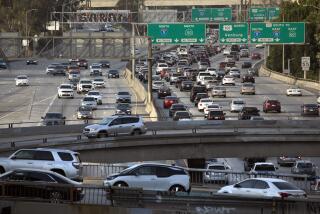Angry Reaction to Japan’s Auto Quota Renewal : Trade: Critics say Japanese-owned factories in the U.S. have made the export limits meaningless.
TOKYO — In a measure that officials hoped would help forestall potential American moves toward protectionism, the Japanese government Friday announced an extension of the quotas on auto exports to the United States.
Minister of International Trade and Industry Eiichi Nakao told a news conference that the quota would remain at 2.3 million passenger cars, a level unchanged since the 1985-86 fiscal year.
But the decision appeared to serve instead as a lightning rod for dissatisfaction in Congress with Japan’s recent behavior in international trade talks and in the Persian Gulf crisis. A group of congressmen including Rep. Richard A. Gephardt (D-Mo.) and John D. Dingell (D-Mich.) called the decision “deeply disturbing” in light of the U.S. auto industry’s financial troubles and what they described as Japan’s inadequate participation in the multinational coalition against Iraq.
In Detroit, Chrysler Chairman Lee A. Iacocca said the decision “exemplifies Japan’s total insensitivity to the economic problems America is now facing and the sacrifices it may soon be called on to make in an area of the world that supplies most of Japan’s oil needs.”
The measure will have little effect on Japanese auto exports to the United States, which have fallen steadily for the past three years. Last year, the Japanese exported roughly 1.9 million cars.
However, the decline has been more than offset by the steady stream of cars pouring out of Japanese-owned factories that have cropped up in America’s heartland during the 1980s while U.S. factories laid off workers and closed their doors. Thus, during the period the import restraints were in effect, Japanese auto makers were able to steadily increase their total U.S. sales to about 3.4 million cars in 1990. Japan’s overall share of the U.S. market climbed to about 28% last year, up from 25% in 1989 and about 12% in 1979.
Among the leading advocates of Japan moving its car production to U.S. turf was the United Auto Workers union. But the UAW said Friday that the limits on sales of Japanese auto makers’ cars must be expanded to cover those vehicles built in the United States as well. The UAW, which has had little success organizing the workers at the “transplant” factories, called for a market-share ceiling on cars sold by Japanese auto makers in the United States, regardless of their source. The market share requirement should also require major increases in the U.S. content of the cars the Japanese build here, the UAW added. The domestic content of the transplant cars is believed to range from 50% to 75%.
Yukata Kume, president of Nissan and head of the Japan Automobile Manufacturers Assn., supports the extension of the quotas on the principle that the decision will show Japan’s good faith in restraining output.
“MITI regards now as the worst time to dismantle the quota, since the three big American auto makers are presently all running in the red,” said Kosuke Yamada, director general of MITI’s Machinery and Information Industries Bureau.
Not all Japanese auto makers support the extension of the export quotas. Isuzu, which now supplies the bulk of its export quota to General Motors, would like to sell more of its popular small cars independently and has complained bitterly about the restraints.
Toyota is also complaining. “We are mature adults, we don’t need artificial restraints,” said Yoshiharu Tateishi, a spokesman for Toyota Motor Co. “We wouldn’t try to suddenly double exports.”
But such complaints get little sympathy among supporters of the U.S. auto industry, who say that the steep rise in production from the eight new Japanese plants in the United States should have been accompanied by a comparable decline in imports from that country.
The “voluntary export restraints” were first set at 1.68 million in 1981 in the midst of a recession induced by rising oil prices and gradually expanded. That afforded U.S. auto makers an opportunity to develop competitive, fuel efficient cars, while simultaneously encouraging Japanese firms to shift production to the United States.
In some ways the quotas served their purpose very well. Japanese production in America soared to 1.3 million last year from zero in 1982. U.S. auto makers have since raised quality and introduced a broader line of small cars.
Meanwhile, as imported vehicles declined, Japan’s U.S. transplants imported large quantities of Japanese parts and engines. Those factors conspired to keep the auto trade deficit high. The deficit was $31 billion last year, down only slightly from $33 billion in 1986.






